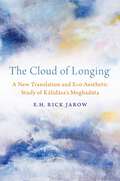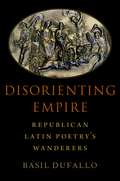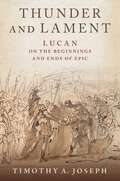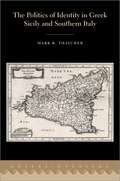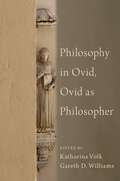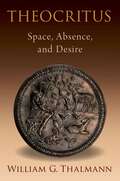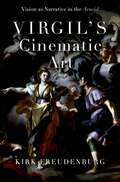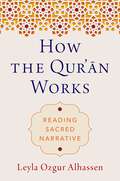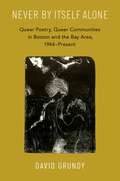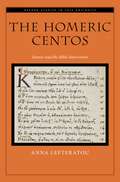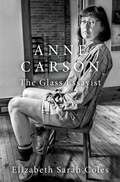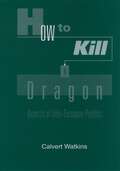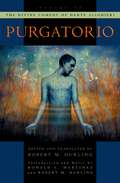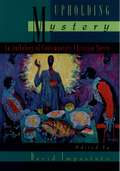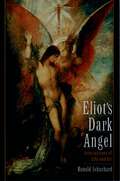- Table View
- List View
The Cloud of Longing: A New Translation and Eco-Aesthetic Study of Kalidasa's Meghaduta
by E. H. JarowA full-length study and new translation of the great Sanskrit poet Kalidasa's famed Meghaduta (literally "The Cloud Messenger,") The Cloud of Longing focuses on the poem's interfacing of nature, feeling, figuration, and mythic memory. This work is unique in its attention given to the natural world in light of the nexus of language and love that is the chief characteristic (lakshana) of the poem. Along with a scrupulous study of the approximately 111 verses of the poem, The Cloud of Longing offers an extended look at how nature was envisioned by classical India's supreme poet as he portrays a cloud's imagined voyage over the fields, valleys, rivers, mountains, and towns of classical India. This sustained, close reading of the Meghaduta will speak to contemporary readers as well as to those committed to developing a more in-depth experience of the natural world. The Cloud of Longing fills a gap in the translation of classical Indian texts, as well as in studies of world literature, religion, and into an emerging integrative environmental discipline.
Disorienting Empire: Republican Latin Poetry's Wanderers
by Basil DufalloDisorienting Empire is the first book to examine Republican Latin poetry's recurring interest in characters who become lost. Basil Dufallo explains the prevalence of this theme with reference to the rapid expansion of Rome's empire in the Middle and Late Republic. It was both a threatening and an enticing prospect, Dufallo argues, to imagine the ever-widening spaces of Roman power as a place where one could become disoriented, both in terms of geographical wandering and in a more abstract sense connected with identity and identification, especially as it concerned gender and sexuality. Plautus, Terence, Lucretius, and Catullus, as well as the "triumviral" Horace of Satires, book 1, all reveal an interest in such experiences, particularly in relation to journeys into the Greek world from which these writers drew their source material. Fragmentary authors such as Naevius, Ennius, and Lucilius, as well as prose historians including Polybius and Livy, add depth and context to the discussion. Setting the Republican poets in dialogue with queer theory and postcolonial theory, Dufallo brings to light both anxieties latent in the theme and the exuberance it suggests over new creative possibilities opened up by reorienting oneself toward new horizons, new identifications-by discovering with pleasure that one could be other than one thought. Further, in showing that the Republican poets had been experimenting with such techniques for generations before the Augustan Age, Disorienting Empire offers its close readings as a means of interpreting afresh Aeneas' wandering journey in Vergil's Aeneid.
Disorienting Empire: Republican Latin Poetry's Wanderers
by Basil DufalloDisorienting Empire is the first book to examine Republican Latin poetry's recurring interest in characters who become lost. Basil Dufallo explains the prevalence of this theme with reference to the rapid expansion of Rome's empire in the Middle and Late Republic. It was both a threatening and an enticing prospect, Dufallo argues, to imagine the ever-widening spaces of Roman power as a place where one could become disoriented, both in terms of geographical wandering and in a more abstract sense connected with identity and identification, especially as it concerned gender and sexuality. Plautus, Terence, Lucretius, and Catullus, as well as the "triumviral" Horace of Satires, book 1, all reveal an interest in such experiences, particularly in relation to journeys into the Greek world from which these writers drew their source material. Fragmentary authors such as Naevius, Ennius, and Lucilius, as well as prose historians including Polybius and Livy, add depth and context to the discussion. Setting the Republican poets in dialogue with queer theory and postcolonial theory, Dufallo brings to light both anxieties latent in the theme and the exuberance it suggests over new creative possibilities opened up by reorienting oneself toward new horizons, new identifications-by discovering with pleasure that one could be other than one thought. Further, in showing that the Republican poets had been experimenting with such techniques for generations before the Augustan Age, Disorienting Empire offers its close readings as a means of interpreting afresh Aeneas' wandering journey in Vergil's Aeneid.
Thunder and Lament: Lucan on the Beginnings and Ends of Epic
by Timothy A. JosephLucan's epic poem Pharsalia tells the story of the cataclysmic "end of Rome" through the victory of Julius Caesar and Caesarism in the civil wars of 49-48 BCE. In Thunder and Lament, Timothy Joseph examines how Lucan's poetic agenda moves in lockstep with his narrative arc, as the poet fashions the Pharsalia to mark the momentous end of the epic genre. To accomplish the closure of the genre, Lucan engages pervasively and polemically with the very first works of Greek and Roman epic - inverting, collapsing, undoing, and completing tropes and themes introduced in Homer's Iliad and Odyssey and in the foundational Latin epic poems by Livius Andronicus, Naevius, and most of all Ennius. Thunder and Lament is the first book-length study of Lucan's engagement with the Homeric poems and the works of early Latin epic. By focusing on Lucan's effort to "surpass the poets of old" - a phrase the poet Statius would use of his achievement - this study deepens our appreciation of Lucan's poetic accomplishment and of the tensions between beginning and ending that lie at the heart of the epic genre. Statius also read Lucan as a poet who both "thunders" and "laments", and Joseph argues that Lucan closes off epic's beginnings through gestures of thundering poetic violence and also through a transformation and completion of the conventional epic mode of lament. Equipped with these two registers of closure, each engaging and taking aim at epic's primal texts, Lucan positions the Pharsalia as epic's final song.
Thunder and Lament: Lucan on the Beginnings and Ends of Epic
by Timothy A. JosephLucan's epic poem Pharsalia tells the story of the cataclysmic "end of Rome" through the victory of Julius Caesar and Caesarism in the civil wars of 49-48 BCE. In Thunder and Lament, Timothy Joseph examines how Lucan's poetic agenda moves in lockstep with his narrative arc, as the poet fashions the Pharsalia to mark the momentous end of the epic genre. To accomplish the closure of the genre, Lucan engages pervasively and polemically with the very first works of Greek and Roman epic - inverting, collapsing, undoing, and completing tropes and themes introduced in Homer's Iliad and Odyssey and in the foundational Latin epic poems by Livius Andronicus, Naevius, and most of all Ennius. Thunder and Lament is the first book-length study of Lucan's engagement with the Homeric poems and the works of early Latin epic. By focusing on Lucan's effort to "surpass the poets of old" - a phrase the poet Statius would use of his achievement - this study deepens our appreciation of Lucan's poetic accomplishment and of the tensions between beginning and ending that lie at the heart of the epic genre. Statius also read Lucan as a poet who both "thunders" and "laments", and Joseph argues that Lucan closes off epic's beginnings through gestures of thundering poetic violence and also through a transformation and completion of the conventional epic mode of lament. Equipped with these two registers of closure, each engaging and taking aim at epic's primal texts, Lucan positions the Pharsalia as epic's final song.
The Politics of Identity in Greek Sicily and Southern Italy (Greeks Overseas)
by Mark R. ThatcherThe Politics of Identity in Greek Sicily and Southern Italy offers the first sustained analysis of the relationship between collective identity and politics in the Greek West during the period c. 600-200 BCE. Greeks defined their communities in multiple and varied ways, including a separate polis identity for each city-state; sub-Hellenic ethnicities such as Dorian and Ionian; regional identities; and an overarching sense of Greekness. Mark Thatcher skillfully untangles the many overlapping strands of these plural identities and carefully analyzes how they relate to each other, presenting a compelling new account of the role of identity in Greek politics. Identity was often created through conflict and was reshaped as political conditions changed. It created legitimacy for kings and tyrants, and it contributed to the decision-making processes of poleis. A series of detailed case studies explore these points by drawing on a wide variety of source material, including historiography, epinician poetry, coinage, inscriptions, religious practices, and material culture. The wide-ranging analysis covers both Sicily and southern Italy, encompassing cities such as Syracuse, Camarina, Croton, and Metapontion; ethnic groups such as the Dorians and Achaeans; and tyrants and politicians from the Deinomenids and Hermocrates to Pyrrhus and Hieron II. Spanning the Archaic, Classical, and Hellenistic periods, this study is an essential contribution to the history, societies, cultures, and identities of Greek Sicily and southern Italy.
The Politics of Identity in Greek Sicily and Southern Italy (Greeks Overseas)
by Mark R. ThatcherThe Politics of Identity in Greek Sicily and Southern Italy offers the first sustained analysis of the relationship between collective identity and politics in the Greek West during the period c. 600-200 BCE. Greeks defined their communities in multiple and varied ways, including a separate polis identity for each city-state; sub-Hellenic ethnicities such as Dorian and Ionian; regional identities; and an overarching sense of Greekness. Mark Thatcher skillfully untangles the many overlapping strands of these plural identities and carefully analyzes how they relate to each other, presenting a compelling new account of the role of identity in Greek politics. Identity was often created through conflict and was reshaped as political conditions changed. It created legitimacy for kings and tyrants, and it contributed to the decision-making processes of poleis. A series of detailed case studies explore these points by drawing on a wide variety of source material, including historiography, epinician poetry, coinage, inscriptions, religious practices, and material culture. The wide-ranging analysis covers both Sicily and southern Italy, encompassing cities such as Syracuse, Camarina, Croton, and Metapontion; ethnic groups such as the Dorians and Achaeans; and tyrants and politicians from the Deinomenids and Hermocrates to Pyrrhus and Hieron II. Spanning the Archaic, Classical, and Hellenistic periods, this study is an essential contribution to the history, societies, cultures, and identities of Greek Sicily and southern Italy.
Philosophy in Ovid, Ovid as Philosopher
Ovid has long been celebrated for the versatility of his poetic imagination, the diversity of his generic experimentation throughout his long career, and his intimate engagement with the Greco-Roman literary tradition that precedes him; but what of his engagement with the philosophical tradition? Ovid's close familiarity with philosophical ideas and with specific philosophical texts has long been recognized, perhaps most prominently in the Pythagorean, Platonic, Empedoclean, and Lucretian shades that have been seen to color his Metamorphoses. This philosophical component has often been perceived as a feature implicated in, and subordinate to, Ovid's larger literary agenda, both pre- and post-exilic; and because of the controlling influence conceded to that literary impulse, readings of the philosophical dimension have often focused on the perceived distortion, ironizing, or parodying of the philosophical sources and ideas on which Ovid draws, as if his literary orientation inevitably compromises or qualifies a "serious" philosophical commitment. Philosophy in Ovid, Ovid as Philosopher counters this tendency by considering Ovid's seriousness of engagement with, and his possible critique of, the philosophical writings that inform his works. The book also questions the feasibility of separating out the categories of the "philosophical" and the "literary" in the first place, and explores the ways in which Ovid may offer unusual, controversial, or provocative reactions to received philosophical ideas. Finally, it investigates the case to be made for viewing the Ovidian corpus not just as a body of writings that are often philosophically inflected, but also as texts that may themselves be read as philosophically adventurous and experimental. The essays collected in this volume are intended at the individual level to address in new ways many aspects of Ovid's recourse to philosophy across his corpus. Collectively, however, they are also designed to redress what, in general terms, remains a significant lacuna in Ovidian studies.
Philosophy in Ovid, Ovid as Philosopher
by Katharina Volk And Gareth D. WilliamsOvid has long been celebrated for the versatility of his poetic imagination, the diversity of his generic experimentation throughout his long career, and his intimate engagement with the Greco-Roman literary tradition that precedes him; but what of his engagement with the philosophical tradition? Ovid's close familiarity with philosophical ideas and with specific philosophical texts has long been recognized, perhaps most prominently in the Pythagorean, Platonic, Empedoclean, and Lucretian shades that have been seen to color his Metamorphoses. This philosophical component has often been perceived as a feature implicated in, and subordinate to, Ovid's larger literary agenda, both pre- and post-exilic; and because of the controlling influence conceded to that literary impulse, readings of the philosophical dimension have often focused on the perceived distortion, ironizing, or parodying of the philosophical sources and ideas on which Ovid draws, as if his literary orientation inevitably compromises or qualifies a "serious" philosophical commitment. Philosophy in Ovid, Ovid as Philosopher counters this tendency by considering Ovid's seriousness of engagement with, and his possible critique of, the philosophical writings that inform his works. The book also questions the feasibility of separating out the categories of the "philosophical" and the "literary" in the first place, and explores the ways in which Ovid may offer unusual, controversial, or provocative reactions to received philosophical ideas. Finally, it investigates the case to be made for viewing the Ovidian corpus not just as a body of writings that are often philosophically inflected, but also as texts that may themselves be read as philosophically adventurous and experimental. The essays collected in this volume are intended at the individual level to address in new ways many aspects of Ovid's recourse to philosophy across his corpus. Collectively, however, they are also designed to redress what, in general terms, remains a significant lacuna in Ovidian studies.
Theocritus: Space, Absence, and Desire
by William G. ThalmannTheocritus: Space, Absence, and Desire discusses many of Theocritus's Idylls with emphasis on how these poems construct space--its contours and borders, along with the people, animals, and objects that fill it--and the equally important role of absence. Drawing on spatial theory from anthropology and cultural geography, author William G. Thalmann studies each poem in itself and in its connections with other poems, so that a loose coherence emerges among them. Spatially, the Ptolemaic empire provides a setting and reference point for the various types of Idylls (bucolic, urban, mythological, and encomiastic poems), in ways that help legitimate it. In all the idylls, however, space is constructed selectively from particular perspectives, so that it reflects and shapes people's relations with each other and humans' relations with nature. The bucolic Idylls in particular raise questions about being in and out of place and relations between self and other that would have been important under the conditions of mobility and intercultural contact in the early Hellenistic period. Yet theirs is a fictional world, defined more by its margins than by its center, and visions of fullness and presence of nature are always distanced from the reader. Absence is constitutive of this world, just as absence of the beloved is the precondition for the desire of bucolic characters and prompts their singing. Their desire mirrors the desire of readers for the absent bucolic world that the poems arouse and that keeps them reading.
Theocritus: Space, Absence, and Desire
by William G. ThalmannTheocritus: Space, Absence, and Desire discusses many of Theocritus's Idylls with emphasis on how these poems construct space--its contours and borders, along with the people, animals, and objects that fill it--and the equally important role of absence. Drawing on spatial theory from anthropology and cultural geography, author William G. Thalmann studies each poem in itself and in its connections with other poems, so that a loose coherence emerges among them. Spatially, the Ptolemaic empire provides a setting and reference point for the various types of Idylls (bucolic, urban, mythological, and encomiastic poems), in ways that help legitimate it. In all the idylls, however, space is constructed selectively from particular perspectives, so that it reflects and shapes people's relations with each other and humans' relations with nature. The bucolic Idylls in particular raise questions about being in and out of place and relations between self and other that would have been important under the conditions of mobility and intercultural contact in the early Hellenistic period. Yet theirs is a fictional world, defined more by its margins than by its center, and visions of fullness and presence of nature are always distanced from the reader. Absence is constitutive of this world, just as absence of the beloved is the precondition for the desire of bucolic characters and prompts their singing. Their desire mirrors the desire of readers for the absent bucolic world that the poems arouse and that keeps them reading.
Virgil's Cinematic Art: Vision as Narrative in the Aeneid
by Kirk FreudenburgVirgil's Cinematic Art concerns the rhetoric of visual manipulation that provokes us to envision what is written on the page, treating visual details in ancient epic not as mere scene-setting information or enhancements to any given story, but as cues for performing specific imaginative processes. Through a series of close readings centered primarily on Virgil's Aeneid, Kirk Freudenburg shows that the experiential effects that Virgil puts into play do serious narrative work of their own by structuring lines of sight, both visual and emotive, and shifting them about in ways that move readers (interpellated as viewers) into and out of the visual and emotional worlds of the story's characters. Studies of visualization in Latin poetry have tended to treat what is seen in epic as a matter of what is there to be seen, rather than an expression of how someone sees, treating images as mostly static. This study, by contrast, concerns the cinematics of ancient narrative: how words provoke an active, forward-moving process of experiential participation; poets not as verbal painters, but as projectors, purveyors of imagined happenings. Informed by cognitivist and constructivist studies of how audiences watch narrative films and make sense of what they are being given to see, Freudenburg locates new narrative content lurking in old places, brought to life within the imaginations of readers. The end result is a new approach to the question of how ancient epic tales convey narrative content through visual means.
Virgil's Cinematic Art: Vision as Narrative in the Aeneid
by Kirk FreudenburgVirgil's Cinematic Art concerns the rhetoric of visual manipulation that provokes us to envision what is written on the page, treating visual details in ancient epic not as mere scene-setting information or enhancements to any given story, but as cues for performing specific imaginative processes. Through a series of close readings centered primarily on Virgil's Aeneid, Kirk Freudenburg shows that the experiential effects that Virgil puts into play do serious narrative work of their own by structuring lines of sight, both visual and emotive, and shifting them about in ways that move readers (interpellated as viewers) into and out of the visual and emotional worlds of the story's characters. Studies of visualization in Latin poetry have tended to treat what is seen in epic as a matter of what is there to be seen, rather than an expression of how someone sees, treating images as mostly static. This study, by contrast, concerns the cinematics of ancient narrative: how words provoke an active, forward-moving process of experiential participation; poets not as verbal painters, but as projectors, purveyors of imagined happenings. Informed by cognitivist and constructivist studies of how audiences watch narrative films and make sense of what they are being given to see, Freudenburg locates new narrative content lurking in old places, brought to life within the imaginations of readers. The end result is a new approach to the question of how ancient epic tales convey narrative content through visual means.
How the Qur'=an Works: Reading Sacred Narrative
by Leyla Ozgur AlhassenThe Qur'an is a text of extraordinary depth and complexity. In How the Qur'an Works, Leyla Ozgur Alhassen takes the reader on a journey through the Qur'an, moving from one verse to another, one story to another, focusing on narratological elements while conducting a close reading in order to understand particular Qur'anic stories and to show how the text's literary techniques enhance its theological agenda. She unpacks the text by focusing on Qur'anic narrative, and specifically, repetition in Qur'anic stories. Repetition is an important part of the Qur'an's literary technique. Ozgur Alhassen traces the use of repetition as a narrative device from the text's overall structure to individual letters. She compares different Qur'anic stories and explores the kinds of repetition that occur in them and what purposes they serve. Repetition, she shows, forges patterns, connections, and layers of meaning that develop, complicate, and comment on the Qur'an's messages.
How the Qur'=an Works: Reading Sacred Narrative
by Leyla Ozgur AlhassenThe Qur'an is a text of extraordinary depth and complexity. In How the Qur'an Works, Leyla Ozgur Alhassen takes the reader on a journey through the Qur'an, moving from one verse to another, one story to another, focusing on narratological elements while conducting a close reading in order to understand particular Qur'anic stories and to show how the text's literary techniques enhance its theological agenda. She unpacks the text by focusing on Qur'anic narrative, and specifically, repetition in Qur'anic stories. Repetition is an important part of the Qur'an's literary technique. Ozgur Alhassen traces the use of repetition as a narrative device from the text's overall structure to individual letters. She compares different Qur'anic stories and explores the kinds of repetition that occur in them and what purposes they serve. Repetition, she shows, forges patterns, connections, and layers of meaning that develop, complicate, and comment on the Qur'an's messages.
Never By Itself Alone: Queer Poetry, Queer Communities in Boston and the Bay Area, 1944?Present
by David GrundyProviding an unprecedented exploration of key moments in queer literary history, Never By Itself Alone changes our sense of both the American literary and political landscapes from the late 1940s through the 21st century. Grundy presents the first comprehensive history of post-war queer writing in Boston and San Francisco, intertwining analysis of lesbian, gay, and queer writing, and insisting on the link between activism and literature. The book centers a host of underrepresented writers, especially writers of color and those with gender non-conforming identities, and challenges the Stonewall exceptionalism of queer historiography. Starting with Robert Duncan's 1944 essay, 'The Homosexual in Society', one of the first significant public defenses of homosexuality in the US, Grundy takes the reader through pioneering works by queer voices of the era, including Adrian Stanford's Black and Queer, the first published book by an out, Black gay poet in the US; the Boston collective Fag Rag and their radical reconsideration of family, private property and the State; the Combahee River Collective, whose Black Feminist analysis drew together race, class, and sexuality; the anthology This Bridge Called My Back, in which women of color spoke truth to power, together; and New Narrative writing, which audaciously mixed Marxism, porn and gossip while uniting against the New Right. Linking these works to the context which produced them, Grundy uncovers the communities formed around activism and small press publishing during this era and elevates neglected voices to narrate a history that before now has never been told in its entirety. Drawing on extensive archival research, Never By Itself Alone is a rigorous and unmatched work of both literary criticism and queer scholarship which underscores the vital importance of radical accounts of race, class, and gender in any queer studies worthy of the name.
Never By Itself Alone: Queer Poetry, Queer Communities in Boston and the Bay Area, 1944?Present
by David GrundyProviding an unprecedented exploration of key moments in queer literary history, Never By Itself Alone changes our sense of both the American literary and political landscapes from the late 1940s through the 21st century. Grundy presents the first comprehensive history of post-war queer writing in Boston and San Francisco, intertwining analysis of lesbian, gay, and queer writing, and insisting on the link between activism and literature. The book centers a host of underrepresented writers, especially writers of color and those with gender non-conforming identities, and challenges the Stonewall exceptionalism of queer historiography. Starting with Robert Duncan's 1944 essay, 'The Homosexual in Society', one of the first significant public defenses of homosexuality in the US, Grundy takes the reader through pioneering works by queer voices of the era, including Adrian Stanford's Black and Queer, the first published book by an out, Black gay poet in the US; the Boston collective Fag Rag and their radical reconsideration of family, private property and the State; the Combahee River Collective, whose Black Feminist analysis drew together race, class, and sexuality; the anthology This Bridge Called My Back, in which women of color spoke truth to power, together; and New Narrative writing, which audaciously mixed Marxism, porn and gossip while uniting against the New Right. Linking these works to the context which produced them, Grundy uncovers the communities formed around activism and small press publishing during this era and elevates neglected voices to narrate a history that before now has never been told in its entirety. Drawing on extensive archival research, Never By Itself Alone is a rigorous and unmatched work of both literary criticism and queer scholarship which underscores the vital importance of radical accounts of race, class, and gender in any queer studies worthy of the name.
The Homeric Centos: Homer and the Bible Interwoven (OXFORD STUDIES IN LATE ANTIQUITY SERIES)
by Anna LefteratouThe Homeric Centos, a poem that is Homeric in style and biblical in theme, is a dramatic illustration of the creative cultural and religious dialogue between Classical Antiquity and Christianity taking place in the Roman Empire during the fifth century CE. The text is attributed to Eudocia, empress and poet, who died in exile in the Holy Land ca. 460. With lines drawn verbatim from Homer's Iliad and Odyssey, the poem begins with the Creation and Fall and ends with Jesus' Resurrection and Ascension. In this blend of Homeric style and Christian themes, there are also echoes of Classical and classicising literature, stretching from Homer and drama to imperial literature. Equally prominent are echoes of earlier Christian canonical and apocryphal works, verse models, and theological works. In The Homeric Centos: Homer and the Bible Interwoven, Anna Lefteratou analyzes the double inspiration of the poem by both classical and Christian traditions. This book explores the works relationship with the cultural milieu of the fifth century CE and offers in-depth analysis of the scenes of Creation and Fall, and Jesus' Passion, Resurrection, and Ascension. This book exposes the work's debt to centuries of Homeric reception and interpretation as well as Christian literature and exegesis, and places it at the crossroads of Christian and pagan literary traditions.
The Homeric Centos: Homer and the Bible Interwoven (OXFORD STUDIES IN LATE ANTIQUITY SERIES)
by Anna LefteratouThe Homeric Centos, a poem that is Homeric in style and biblical in theme, is a dramatic illustration of the creative cultural and religious dialogue between Classical Antiquity and Christianity taking place in the Roman Empire during the fifth century CE. The text is attributed to Eudocia, empress and poet, who died in exile in the Holy Land ca. 460. With lines drawn verbatim from Homer's Iliad and Odyssey, the poem begins with the Creation and Fall and ends with Jesus' Resurrection and Ascension. In this blend of Homeric style and Christian themes, there are also echoes of Classical and classicising literature, stretching from Homer and drama to imperial literature. Equally prominent are echoes of earlier Christian canonical and apocryphal works, verse models, and theological works. In The Homeric Centos: Homer and the Bible Interwoven, Anna Lefteratou analyzes the double inspiration of the poem by both classical and Christian traditions. This book explores the works relationship with the cultural milieu of the fifth century CE and offers in-depth analysis of the scenes of Creation and Fall, and Jesus' Passion, Resurrection, and Ascension. This book exposes the work's debt to centuries of Homeric reception and interpretation as well as Christian literature and exegesis, and places it at the crossroads of Christian and pagan literary traditions.
Anne Carson: The Glass Essayist
by Elizabeth Sarah ColesThe scholar is transparent and accountable, the poet inward and errant: anyone who reads Anne Carson has to suspend many such separations of power. The first monographic study of her work to date, Anne Carson: The Glass Essayist makes the case for the acclaimed poet, classicist, and translator as a remarkable experimental scholar and reader, who rehearses scholarly methods while slipping their constraints of form and emotion. Carson's attention to sources-ancient and modern, textual or visual-is one of few constants across almost four decades of her published writing, whose uncertain claims on discipline and genre are claimed here as a certain interpretive style. The book follows Carson's readings through variations in form-from early academic prose and poem-essays to creative adaptations and works for performance-to come to grips with what Coles calls Carson's transparency: not her easiness or literalism, but a taste for the exposure of her presence, process, and intent. Carson's portraits of working perform to readers even where she fantasizes her own erasure; where chance, poetic economy, impersonation, and imitation ride the line of anonymity. Coles situates Carson in a vibrant contemporary conversation around the essay, scholar-poets, and post-critical form, where creation transacts critique, and where roles and prerogatives are reset. Reading Carson as a reader, the book argues, is the most pressing way of reading her now.
Anne Carson: The Glass Essayist
by Elizabeth Sarah ColesThe scholar is transparent and accountable, the poet inward and errant: anyone who reads Anne Carson has to suspend many such separations of power. The first monographic study of her work to date, Anne Carson: The Glass Essayist makes the case for the acclaimed poet, classicist, and translator as a remarkable experimental scholar and reader, who rehearses scholarly methods while slipping their constraints of form and emotion. Carson's attention to sources-ancient and modern, textual or visual-is one of few constants across almost four decades of her published writing, whose uncertain claims on discipline and genre are claimed here as a certain interpretive style. The book follows Carson's readings through variations in form-from early academic prose and poem-essays to creative adaptations and works for performance-to come to grips with what Coles calls Carson's transparency: not her easiness or literalism, but a taste for the exposure of her presence, process, and intent. Carson's portraits of working perform to readers even where she fantasizes her own erasure; where chance, poetic economy, impersonation, and imitation ride the line of anonymity. Coles situates Carson in a vibrant contemporary conversation around the essay, scholar-poets, and post-critical form, where creation transacts critique, and where roles and prerogatives are reset. Reading Carson as a reader, the book argues, is the most pressing way of reading her now.
The Divine Comedy of Dante Alighieri: Volume 2: Purgatorio (First Avenue Classics)
by Robert M. DurlingIn the early 1300s, Dante Alighieri set out to write the three volumes which make the up The Divine Comedy. Purgatorio is the second volume in this set and opens with Dante the poet picturing Dante the pilgrim coming out of the pit of hell. Similar to the Inferno (34 cantos), this volume is divided into 33 cantos, written in tercets (groups of 3 lines). The English prose is arranged in tercets to facilitate easy correspondence to the verse form of the Italian on the facing page, enabling the reader to follow both languages line by line. In an effort to capture the peculiarities of Dante's original language, this translation strives toward the literal and sheds new light on the shape of the poem. Again the text of Purgatorio follows Petrocchi's La Commedia secondo l'antica vulgata, but the editor has departed from Petrocchi's readings in a number of cases, somewhat larger than in the previous Inferno, not without consideration of recent critical readings of the Comedy by scholars such as Lanza (1995, 1997) and Sanguineti (2001). As before, Petrocchi's punctuation has been lightened and American norms have been followed. However, without any pretensions to being "critical", the text presented here is electic and being not persuaded of the exclusive authority of any manuscript, the editor has felt free to adopt readings from various branches of the stemma. One major addition to this second volume is in the notes, where is found the Intercantica - a section for each canto that discusses its relation to the Inferno and which will make it easier for the reader to relate the different parts of the Comedy as a whole.
Upholding Mystery: An Anthology of Contemporary Christian Poetry
by David ImpastatoMost readers of contemporary poetry would agree with literary critic Helen Vendler that "there is no significant poet whose work does not mirror, both formally and in its preoccupations, the absence of the transcendent"--that no major modern poet writes religious poetry. Indeed, the very idea that a vital Christian poetry might arise within our thoroughly secular culture seems almost inconceivable. Is it possible that a body of Christian poetry is now being produced whose literary merit is equal to its religious conviction? David Impastato's splendid anthology, Upholding Mystery, answers that question with a resounding and surprising "yes." From Andrew Hudgins' often humorous narratives to Geoffery Hill's darkly impassioned lyrics, from Denise Levertov's incisive personal and political insights to Wendell Berry's lovely evocations of the divine presence in nature, Upholding Mystery offers readers a wide range of both poetic and spiritual satisfactions. Featuring only poets who are currently writing--including such well-known poets as Richard Wilbur, Annie Dillard, Daniel Berrigan, Les Murray, and Louise Erdrich, along with the impressive though less-known voices of David Craig, Scott Cairns, and David Brendan Hopes--this superb anthology provides generous selections of work that is admirable equally for the stature of its verse and for its illumination of the Christian ethos. By limiting the number of poets included, this collection allows readers to gain a thorough familiarity with each poet's work and to see how each struggles with, celebrates, and embodies a vision of the sacred throughout a personal body of verse. In addition, editor David Impastato provides brief, accessible, extremely helpful introductions that highlight the specifically Christian concerns of the poems, and he organizes the book into sections dealing with such topics as The Cross, Transformation, Injustice, Presence, Praise, The Mystical Body, and so on, thereby giving the reader a coherent theological journey as well as the pleasurable experience of the individual poems. Here, then, is a contemporary encounter with Christian mystery, in poetry that is as vibrant, as compelling, and as meaningful as any being written today. David Impastato has done an invaluable service in showing that the transcendent is indeed alive and well in the hands of contemporary poets, despite reports to the contrary, and in gathering a dazzling array of poems that will appeal in equal measure to religious and literary readers alike.
Eliot's Dark Angel: Intersections Of Life And Art
by Ronald SchuchardSchuchard's critical study draws upon previously unpublished and uncollected materials in showing how Eliot's personal voice works through the sordid, the bawdy, the blasphemous, and the horrific to create a unique moral world and the only theory of moral criticism in English literature. The book also erodes conventional attitudes toward Eliot's intellectual and spiritual development, showing how early and consistently his classical and religious sensibility manifests itself in his poetry and criticism. The book examines his reading, his teaching, his bawdy poems, and his life-long attraction to music halls and other modes of popular culture to show the complex relation between intellectual biography and art.
